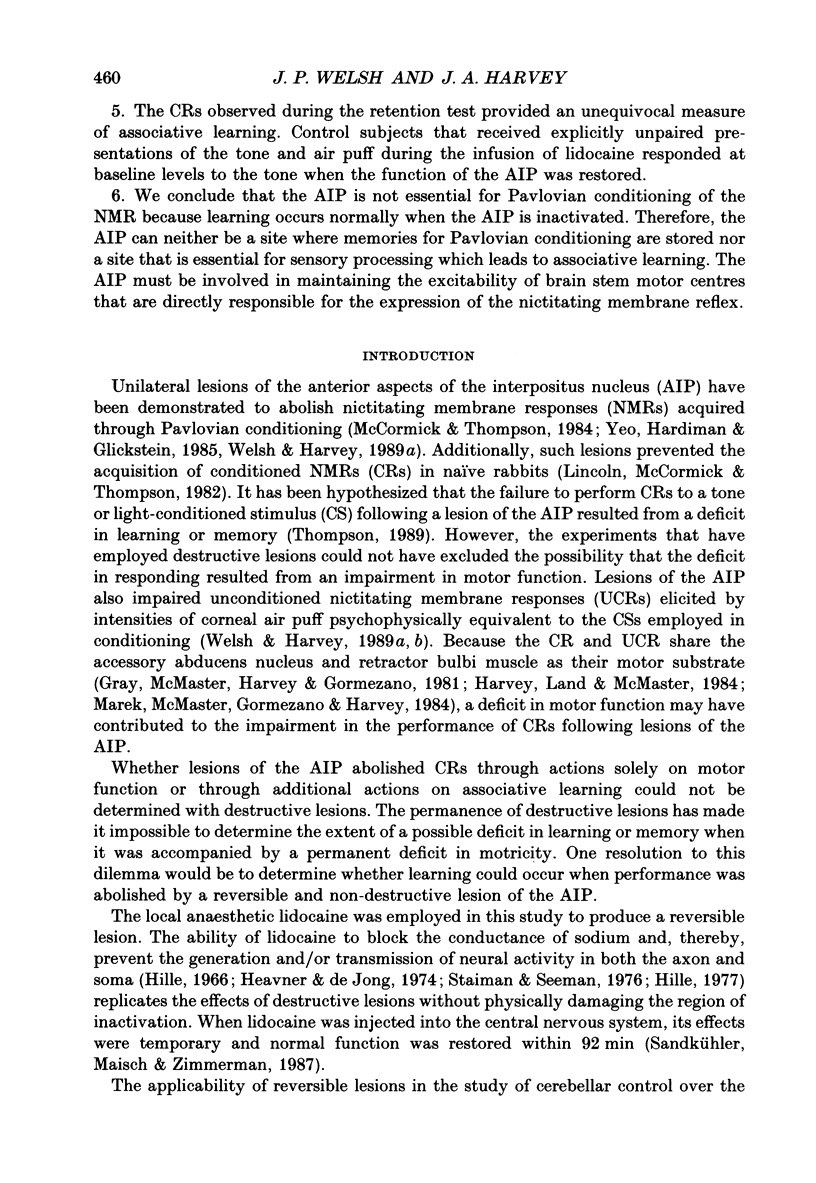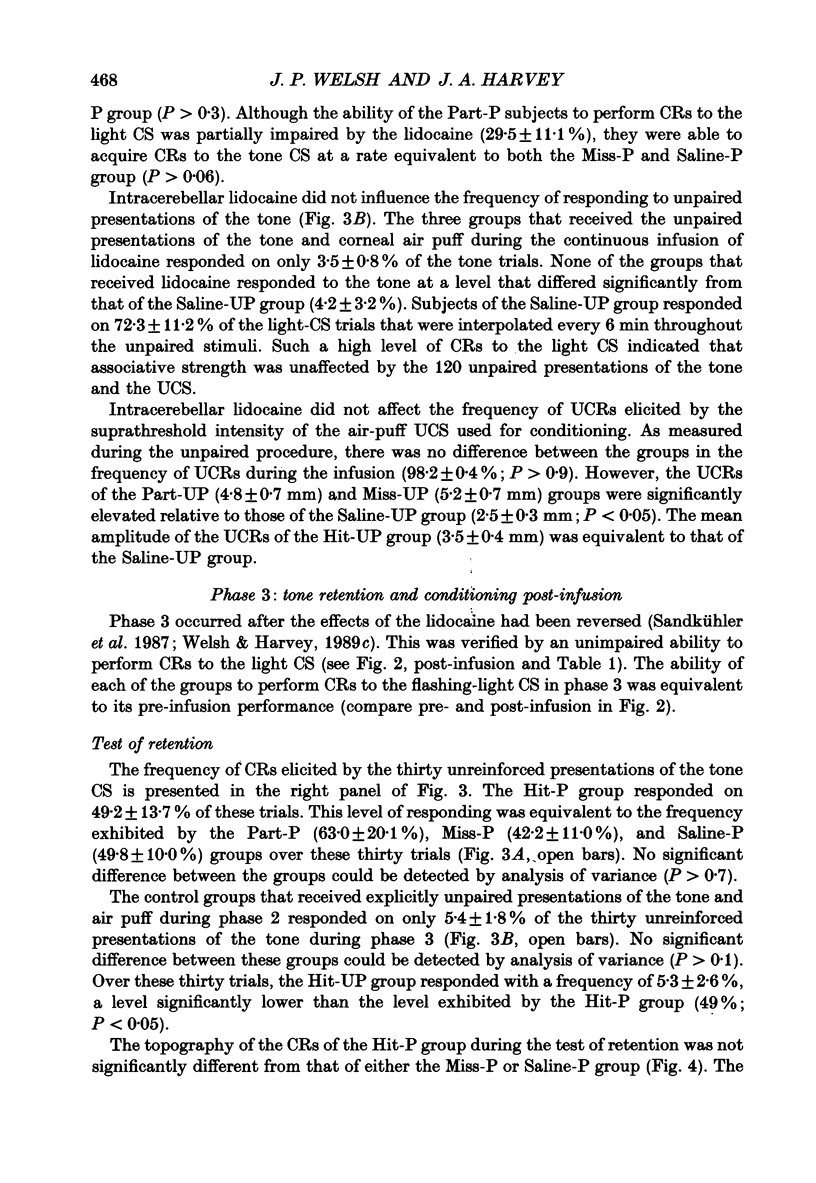Abstract
1. We have examined the role of the anterior interpositus nucleus (AIP) of the cerebellum in Pavlovian conditioning of the nictitating membrane response (NMR) of the rabbit with the use of reversible brain lesions produced by the local anaesthetic lidocaine. Previous experiments have demonstrated that destructive lesions of the AIP prevent the performance of conditioned NMRs (CRs). Microinjections of lidocaine into the AIP were used in the present experiment to determine whether the deficit in the performance of CRs resulted from a deficit in learning or memory. 2. A 3-phase procedure was employed to determine whether associative learning required the function of the AIP. In phase 1, rabbits were trained to make CRs to a flashing-light conditioned stimulus (CS) that was paired with an air-puff unconditioned stimulus (UCS) directed at the cornea. In phase 2, the AIP was anaesthetized during a session of conditioning in which a tone CS was paired with the UCS. Presentations of the light CS were interpolated throughout the tone conditioning in order to monitor the degree to which CRs were impaired by lidocaine. Phase 3 occurred after the effects of the lidocaine had dissipated and consisted of a test of retention to determine whether learning occurred during phase 2 but could not be expressed because of a performance deficit resulting from the inactivation of the AIP. 3. Infusion of lidocaine into the AIP abolished CRs to the light CS and prevented the performance of CRs to the tone CS in phase 2. The effect of the infusion was specifically due to a conduction block of neurons and/or fibres in the lateral aspect of the AIP. The infusion of lidocaine into regions surrounding the AIP did not affect CRs elicited by the light CS or prevent acquisition of CRs to the tone. Infusions of saline directly into the AIP did not impair the performance of CRs to either the tone or light CS. Quantitative analysis of diffusion revealed that the abolition of CRs was accompanied by anaesthetization of the AIP. 4. The retention test in phase 3 indicated that learning occurred normally during phase 2 when the AIP was inactivated and performance was abolished. When the function of the AIP was restored and performance had recovered, the subjects demonstrated a frequency of CRs to the tone CS that was indistinguishable from control subjects whose performance had never been impaired. 5. The CRs observed during the retention test provided an unequivocal measure of associative learning.(ABSTRACT TRUNCATED AT 400 WORDS)
Full text
PDF





















Images in this article
Selected References
These references are in PubMed. This may not be the complete list of references from this article.
- BECK E. C., DOTY R. W. Conditioned flexion reflexes acquired during combined catalepsy and de-efferentation. J Comp Physiol Psychol. 1957 Jun;50(3):211–216. doi: 10.1037/h0047207. [DOI] [PubMed] [Google Scholar]
- Geary W. A., 2nd, Wooten G. F. Quantitative film autoradiography of opiate agonist and antagonist binding in rat brain. J Pharmacol Exp Ther. 1983 Apr;225(1):234–240. [PubMed] [Google Scholar]
- Gray T. S., McMaster S. E., Harvey J. A., Gormezano I. Localization of retractor bulbi motoneurons in the rabbit. Brain Res. 1981 Dec 7;226(1-2):93–106. doi: 10.1016/0006-8993(81)91085-4. [DOI] [PubMed] [Google Scholar]
- Harvey J. A., Land T., McMaster S. E. Anatomical study of the rabbit's corneal-VIth nerve reflex: connections between cornea, trigeminal sensory complex, and the abducens and accessory abducens nuclei. Brain Res. 1984 Jun 3;301(2):307–321. doi: 10.1016/0006-8993(84)91100-4. [DOI] [PubMed] [Google Scholar]
- Heavner J. E., de Jong R. H. Lidocaine blocking concentrations for B- and C-nerve fibers. Anesthesiology. 1974 Mar;40(3):228–233. doi: 10.1097/00000542-197403000-00004. [DOI] [PubMed] [Google Scholar]
- Hille B. Common mode of action of three agents that decrease the transient change in sodium permeability in nerves. Nature. 1966 Jun 18;210(5042):1220–1222. doi: 10.1038/2101220a0. [DOI] [PubMed] [Google Scholar]
- Hille B. The pH-dependent rate of action of local anesthetics on the node of Ranvier. J Gen Physiol. 1977 Apr;69(4):475–496. doi: 10.1085/jgp.69.4.475. [DOI] [PMC free article] [PubMed] [Google Scholar]
- Kelly T. M., Zuo C. C., Bloedel J. R. Classical conditioning of the eyeblink reflex in the decerebrate-decerebellate rabbit. Behav Brain Res. 1990 Apr 16;38(1):7–18. doi: 10.1016/0166-4328(90)90019-b. [DOI] [PubMed] [Google Scholar]
- Kuno M., Matsuura S. Sites and mechanisms of action of lidocaine upon the isolated spinal cord of the frog. Brain Res. 1982 Oct 7;249(1):87–93. doi: 10.1016/0006-8993(82)90172-x. [DOI] [PubMed] [Google Scholar]
- Lincoln J. S., McCormick D. A., Thompson R. F. Ipsilateral cerebellar lesions prevent learning of the classically conditioned nictitating membrane/eyelid response. Brain Res. 1982 Jun 17;242(1):190–193. doi: 10.1016/0006-8993(82)90510-8. [DOI] [PubMed] [Google Scholar]
- Marek G. J., McMaster S. E., Gormezano I., Harvey J. A. The role of the accessory abducens nucleus in the rabbit nictitating membrane response. Brain Res. 1984 May 14;299(2):215–229. doi: 10.1016/0006-8993(84)90703-0. [DOI] [PubMed] [Google Scholar]
- McCormick D. A., Guyer P. E., Thompson R. F. Superior cerebellar peduncle lesions selectively abolish the ipsilateral classically conditioned nictitating membrane/eyelid response of the rabbit. Brain Res. 1982 Jul 29;244(2):347–350. doi: 10.1016/0006-8993(82)90095-6. [DOI] [PubMed] [Google Scholar]
- McCormick D. A., Thompson R. F. Cerebellum: essential involvement in the classically conditioned eyelid response. Science. 1984 Jan 20;223(4633):296–299. doi: 10.1126/science.6701513. [DOI] [PubMed] [Google Scholar]
- Olds J. L., Anderson M. L., McPhie D. L., Staten L. D., Alkon D. L. Imaging of memory-specific changes in the distribution of protein kinase C in the hippocampus. Science. 1989 Aug 25;245(4920):866–869. doi: 10.1126/science.2772638. [DOI] [PubMed] [Google Scholar]
- Sandkühler J., Maisch B., Zimmermann M. The use of local anaesthetic microinjections to identify central pathways: a quantitative evaluation of the time course and extent of the neuronal block. Exp Brain Res. 1987;68(1):168–178. doi: 10.1007/BF00255242. [DOI] [PubMed] [Google Scholar]
- Staiman A., Seeman P. Conduction-blocking concentrations of anesthetics increase with nerve axon diameter: studies with alcohol, lidocaine and tetrodotoxin on single myelinated fibers. J Pharmacol Exp Ther. 1977 May;201(2):340–349. [PubMed] [Google Scholar]
- Welsh J. P., Harvey J. A. Cerebellar lesions and the nictitating membrane reflex: performance deficits of the conditioned and unconditioned response. J Neurosci. 1989 Jan;9(1):299–311. doi: 10.1523/JNEUROSCI.09-01-00299.1989. [DOI] [PMC free article] [PubMed] [Google Scholar]
- Yeo C. H., Hardiman M. J., Glickstein M. Classical conditioning of the nictitating membrane response of the rabbit. I. Lesions of the cerebellar nuclei. Exp Brain Res. 1985;60(1):87–98. doi: 10.1007/BF00237022. [DOI] [PubMed] [Google Scholar]




